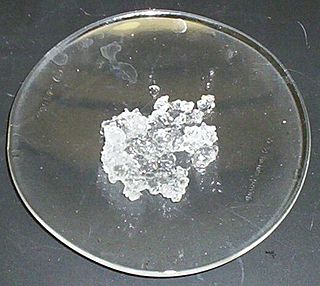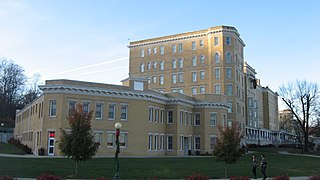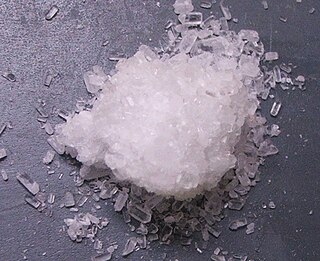
Lithium carbonate is an inorganic compound, the lithium salt of carbonic acid with the formula Li
2CO
3. This white salt is widely used in processing metal oxides. It is on the World Health Organization's List of Essential Medicines for its efficacy in the treatment of mood disorders such as bipolar disorder.

Laxatives, purgatives, or aperients are substances that loosen stools and increase bowel movements. They are used to treat and prevent constipation.

Magnesium sulfate or magnesium sulphate is a chemical compound, a salt with the formula MgSO4, consisting of magnesium cations Mg2+ (20.19% by mass) and sulfate anions SO2−4. It is a white crystalline solid, soluble in water but not in ethanol.

Magnesium chloride is an inorganic compound with the formula MgCl2. It forms hydrates MgCl2·nH2O, where n can range from 1 to 12. These salts are colorless or white solids that are highly soluble in water. These compounds and their solutions, both of which occur in nature, have a variety of practical uses. Anhydrous magnesium chloride is the principal precursor to magnesium metal, which is produced on a large scale. Hydrated magnesium chloride is the form most readily available.

Epsomite, Epsom salt, or magnesium sulfate heptahydrate, is a hydrous magnesium sulfate mineral with formula MgSO4·7H2O.

Sodium sulfate (also known as sodium sulphate or sulfate of soda) is the inorganic compound with formula Na2SO4 as well as several related hydrates. All forms are white solids that are highly soluble in water. With an annual production of 6 million tonnes, the decahydrate is a major commodity chemical product. It is mainly used as a filler in the manufacture of powdered home laundry detergents and in the Kraft process of paper pulping for making highly alkaline sulfides.

Mineral springs are naturally occurring springs that produce hard water, water that contains dissolved minerals. Salts, sulfur compounds, and gases are among the substances that can be dissolved in the spring water during its passage underground. In this they are unlike sweet springs, which produce soft water with no noticeable dissolved gasses. The dissolved minerals may alter the water's taste. Mineral water obtained from mineral springs, and the precipitated salts such as Epsom salt have long been important commercial products.

Barium nitrate is the inorganic compound with the chemical formula Ba(NO3)2. It, like most barium salts, is colorless, toxic, and water-soluble. It burns with a green flame and is an oxidizer; the compound is commonly used in pyrotechnics.

A mineral lick is a place where animals can go to lick essential mineral nutrients from a deposit of salts and other minerals. Mineral licks can be naturally occurring or artificial. Natural licks are common, and they provide essential elements such as phosphorus and the biometals required for bone, muscle and other growth in herbivorous mammals such as deer, moose, elephants, hippos, rhinos, tapirs, woodchucks, fox squirrels, mountain goats, porcupines, and frugivorous bats. Such licks are especially important in ecosystems such as tropical rainforests with poor general availability of nutrients. Harsh weather exposes salty mineral deposits that draw animals from miles away for a taste of needed nutrients. It is thought that certain fauna can detect calcium in salt licks.

Water softening is the removal of calcium, magnesium, and certain other metal cations in hard water. The resulting soft water requires less soap for the same cleaning effort, as soap is not wasted bonding with calcium ions. Soft water also extends the lifetime of plumbing by reducing or eliminating scale build-up in pipes and fittings. Water softening is usually achieved using lime softening or ion-exchange resins, but is increasingly being accomplished using nanofiltration or reverse osmosis membranes.

Bath salts are water-soluble, pulverized minerals that are added to water to be used for bathing. It is said that these salts improve cleaning, enhance the enjoyment of bathing, and serve as a vehicle for cosmetic agents. Bath salts have been developed which mimic the properties of natural mineral baths or hot springs. Some bath salts contain glycerine so the product will act as an emollient, humectant, or lubricant. Fragrances and colors are often added to bath salts; the fragrances are used to increase the users' enjoyment of the bathing experience.

The French Lick Springs Hotel, a part of the French Lick Resort complex, is a major resort hotel in Orange County, Indiana. The historic hotel in the national historic district at French Lick was initially known as a mineral spring health spa and for its trademarked Pluto Water. During the period 1901 to 1946, when Thomas Taggart, a former mayor of Indianapolis, and his son, Thomas D. Taggart, were its owners and operators, the popular hotel attracted many fashionable, wealthy, and notable guests. The resort was a major employer of African-American labor, which mostly came from Kentucky.
Donat is a natural mineral water from the springs of Rogaška Slatina in Slovenia. It has a high content of magnesium. It helps with constipation problems, heartburn and magnesium deficiency problems.

Lithia Spring Water is an American brand of high mineral content lithia water that naturally contains lithium carbonate. Since 1888 it has been sourced from an ancient Native American sacred spring that is part of the Stone Mountain, Georgia, geological pluton formation. Located at Lithia Springs, Georgia, on the boundary of Cobb and Douglas counties, approximately twelve miles from the city of Atlanta.
The West Baden Sprudels were an early Negro league baseball team that played as an independent club owned by the Burnett-Pollard-Rogers Baseball Club Company, where Edward Rogers was the Chief Officer.
Magnesium salts are available as a medication in a number of formulations. They are used to treat magnesium deficiency, low blood magnesium, eclampsia, and several other conditions. Magnesium is an essential nutrient.

Sal Hepatica is the name of a mineral salt laxative that was produced and marketed by Bristol-Myers from its inception in 1887, becoming its first nationally recognized product in 1903, until 1958. When dissolved in water, it was said to reproduce the taste and effect of the natural mineral waters of Bohemia.
The spring of Mohai Agnes is in Hungary in Fejér county next to the Bakony hill in Moha village.
The French Lick Plutos were an early independent Negro league baseball club, which was based in French Lick, Indiana, from 1912 to 1914. They were alternately known as the Red Devils.

Magnesium sulfate as a medication is used to treat and prevent low blood magnesium and seizures in women with eclampsia. It is also used in the treatment of torsades de pointes, severe asthma exacerbations, constipation, and barium poisoning. It is given by injection into a vein or muscle as well as by mouth. As epsom salts, it is also used for mineral baths.























